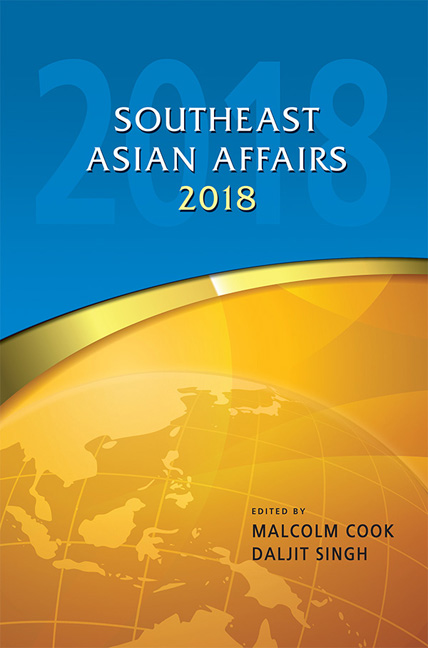Book contents
- Frontmatter
- Contents
- Introduction
- Acknowledgements
- THE REGION
- Notes on the Future of Southeast Asian Studies
- Southeast Asia on the Economic Front: Holding Steady, Bracing for Change
- Year One of the Trump Administration's Policy: Uncertainty and Continuity
- Southeast Asia in 2017: Grappling with Uncertainty
- BRUNEI DARUSSALAM
- CAMBODIA
- INDONESIA
- LAOS
- MALAYSIA
- MYANMAR
- THE PHILIPPINES
- SINGAPORE
- THAILAND
- TIMOR-LESTE
- VIETNAM
Southeast Asia on the Economic Front: Holding Steady, Bracing for Change
from THE REGION
Published online by Cambridge University Press: 08 June 2019
- Frontmatter
- Contents
- Introduction
- Acknowledgements
- THE REGION
- Notes on the Future of Southeast Asian Studies
- Southeast Asia on the Economic Front: Holding Steady, Bracing for Change
- Year One of the Trump Administration's Policy: Uncertainty and Continuity
- Southeast Asia in 2017: Grappling with Uncertainty
- BRUNEI DARUSSALAM
- CAMBODIA
- INDONESIA
- LAOS
- MALAYSIA
- MYANMAR
- THE PHILIPPINES
- SINGAPORE
- THAILAND
- TIMOR-LESTE
- VIETNAM
Summary
A Welcome Lull
The year 2017 passed with nothing matching the political spectacles of 2016 or the economic vagaries of 2014–15. Less drama was probably welcomed, and the Southeast Asian region, as with much of the world, waited to see the eventual outcome of Donald Trump's election and the Brexit vote, while seeking to manage economic growth amid relative stability in commodity prices and currency values, and freedom from major shocks.
Between 2016 and 2017, Southeast Asian economies increased or maintained economic growth. Investment and trade kept healthy levels, boosted by improved conditions in the world's major economies, export markets and investment sources. In 2017, prospects of new economic opportunities unfolded, as well as challenges in regional and multilateral relations. China officially launched the Belt and Road Initiative. And the Trump presidency tempered stances that previously were more hostile towards trade surpluses, and completed a cordial, non-confrontational East Asia tour in November.
An upswing in exports, alongside sustained domestic and foreign direct investment (FDI), bodes well for economic growth ahead. However, increased trade deficits with China are a regional cause for concern. Country-specific deficits in trade and the current account, which make economies dependent on capital inflows, and in government budgets, which considerably derive from infrastructure development, highlight the importance of facilitating prudent and productive investments and expenditures, and competitive exports.
The backdrop of macroeconomic stability and steady growth set the tone for policy considerations of a more long-term and structural nature. While each Southeast Asian country has distinct circumstances, constraints and priorities, three salient and emergent issues warrant our attention. The first revolves around structural change and the future of manufacturing. Southeast Asia faces challenges in building productive capacity, upgrading skills, promoting innovation and adapting to technological change. Second, the region also grapples with labour market issues: generating employment and wage growth, alongside societal demands to safeguard welfare and protect the vulnerable. Third, infrastructure is a burgeoning priority. Southeast Asian countries have committed to massive transportation and utility projects, which hold out potential to generate multiplier effects, but also pose challenges in project delivery and financial sustainability.
- Type
- Chapter
- Information
- Southeast Asian Affairs 2018 , pp. 19 - 42Publisher: ISEAS–Yusof Ishak InstitutePrint publication year: 2018



